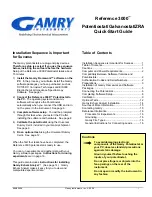
ENGLISH
19
12.3 User Recommendations for Use During and After Phototherapy
During Phototherapy
•
Select the site at which the Bili
Chek®
measurement will be taken. The preferred site is the flat area of the
forehead between the infant’s eyebrows.
•
A photo-opaque
1
material (such as Bil
Eclipse
™ Phototherapy Protective Patch or adhesive skin patches) must be
positioned over the measurement site on the forehead
prior to the start of phototherapy
. Any necessary
precautions should be taken to ensure that the material does not move in such a way as to expose the measurement
site to the phototherapy lights.
•
All phototherapy lights should be turned off while a Bili
Chek
measurement is taken. Ensure that the preferred
measurement site is still covered. Open the Bil
Eclipse
protective patch light blocking material and take the
Bili
Chek
measurement from the preferred site. Close the Bil
Eclipse
flap and continue the phototherapy or remove
the Bil
Eclipse
and discontinue the phototherapy as indicated. (You may choose to leave the Bil
Eclipse
in place
after phototherapy is discontinued to identify the correct measurement site for future measurements.)
NOTE: Studies on the repeatability of the Bili
Chek
measurement have established precision specifications (see
the Clinical Indications For Use for details). The source of variation in the measurement is the
heterogeneous nature of skin and the bilirubin deposition. Small changes in successive transcutaneous
bilirubin measurement of less than 2.0 mg/dL or 34 µmol/L (increases or decreases) should not be
interpreted as definite trends.
Respironics recommends the use of the Bil
Eclipse
Phototherapy Protective Patch for all forms of phototherapy use.
Some degree of light blocking can be provided with the other methods listed below.
Bil
Eclipse
1.
Always clean the skin site before you place the Bil
Eclipse
on the infant.
Respironics makes no recommendations on the type of cleaning agent that is used.
Any liquids, lotions, or creams will reduce the adhesiveness of the patch and
increase the likelihood that it will fall off during phototherapy.
2.
When you lift the LID of the patch to take a measurement, it may be helpful to place
your finger on the edge of the BASE in order to make sure that the entire patch is
not pulled off of the infant’s skin.
3.
When you close the LID, make sure that it is in good contact with the BASE around
the entire patch. Although it is unlikely that light will penetrate the sides, any light
that does reach the skin could affect the Bili
Chek
measurement.
4.
After phototherapy has been completed, it is recommended that the Bil
Eclipse
be left on the skin until no
future Bili
Chek
measurements are likely to be made. Although no further changes in the skin will occur after
the phototherapy lights are turned off, leaving the patch in place will ensure that future measurements are
made from the same, protected location.
Eye Patches:
Take precautions to ensure that the eye patches cover a large portion of the forehead, especially the site at which the
Bili
Chek
measurement will be taken. Secure the eye patches to prevent them from moving and exposing the measure-
ment site to the phototherapy lights.
Adhesive Skin Patches:
Place the adhesive skin patch on the forehead at an anatomic site, such as between the infant’s eyebrows, which can be
identified even after the patch has been removed after phototherapy has been discontinued. Commonly available patches
for skin temperature probes and monitor leads can be used for this purpose provided they are opaque to light. As an extra
precaution, the patches can be left in place even after the phototherapy has been discontinued in order to identify the
correct measurement site.
1
Chin KC, MJ Moseley and SC Bayless “Light Transmission of Phototherapy Eyeshields,”
Arch of Dis in Childhood,
1987, 62(9), pp 970-1
Содержание bilichek
Страница 2: ...ENGLISH ...





































